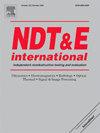基于红外热成像的参数化空心边界识别方法研究
IF 4.5
2区 材料科学
Q1 MATERIALS SCIENCE, CHARACTERIZATION & TESTING
引用次数: 0
摘要
空心化问题威胁着文物的完整性。红外热成像提供了识别空洞的基础,但难以准确确定其边界。现有的方法主要依赖于传统的热成像参数,缺乏对复杂野外条件下空洞热敏特征的提取和分析的系统研究。特别是对岩石艺术中空心边界的精确检测的研究仍然有限。基于换热理论,构建了空心区温度场分布模型,量化了空心区热扩散的动态特性。提出了一种基于红外热成像技术计算空心半径的新方法,并通过数值模拟对该方法中未知参数β进行了相关性分析。根据分析结果,建立了参数β、ω与R之间的定量关系。为了检验计算方法在复杂表面条件下的精度,对200个不同空心半径的测点进行了计算,其中73%的测点的相对误差小于14%。实验还从时间和空心尺寸的角度对不同方法的误差性能进行了综合分析。实验还分析了不同方法的误差性能。该分析同时考虑了时间维度和空心区域的大小。实验还从时间和空心尺寸维度对不同方法的误差性能进行了综合分析。结果表明,本文方法的平均相对错误率为9.89%,标准差为0.22,而现有方法的平均相对错误率为16.69 ~ 24.82%,标准差为0.32 ~ 0.42,准确度和稳定性优势明显,与其他方法相比波动最小,稳定性最好。该方法还应用于大麦地岩画的现场空心检测。并与现场硬度测试法进行了性能比较。两种方法在识别空心边界方面的结果相似。进一步验证了所提方法的可靠性和适用性。本文章由计算机程序翻译,如有差异,请以英文原文为准。
Study on the parameterized hollow boundary identification method based on infrared thermal imaging
The problem of hollowing threatens the integrity of cultural relics. Infrared thermography provides a basis for identifying hollows but struggles to accurately determine their boundaries. Existing methods predominantly rely on conventional thermographic parameters and lack systematic studies on the extraction and analysis of thermally sensitive features of hollows under complex field conditions. In particular, research on the precise detection of hollow boundaries in rock art remains limited. Based on the theory of heat transfer, this paper constructs a distribution model of the temperature field in the hollow region, quantifying the dynamic characteristics of heat diffusion in the hollow area. A new method for calculating the hollow radius based on infrared thermography is proposed, and a correlation analysis of the unknown parameter β in this method is conducted using numerical simulation. Based on the analysis results, a quantitative relationship between the parameter β, ω and R is established. To test the accuracy of the computational method under complex surface conditions, calculations were performed on 200 measurement points with different hollow radii, among which 73 % of the points had a relative error of less than 14 %. The experiment also conducted a comprehensive analysis of the error performance of different methods from the perspectives of time and hollow size. The experiment also analyzed the error performance of different methods. This analysis considered both the time dimension and the size of the hollow areas. The experiment also conducted a comprehensive analysis of the error performance of different methods from the time and hollow size dimensions. The results show that the method in this paper achieves an average relative error rate of 9.89 % and a standard deviation of 0.22, compared to 16.69–24.82 % and 0.32–0.42 respectively in existing methods, demonstrating clear advantages in accuracy and stability, demonstrating the smallest fluctuation and the best stability compared to other methods. This method was also applied to on-site hollow detection in the Damaidi rock paintings. Its performance was compared with the on-site hardness testing method. Both methods gave similar results in identifying hollow boundaries. This further confirms the reliability and applicability of the proposed method.
求助全文
通过发布文献求助,成功后即可免费获取论文全文。
去求助
来源期刊

Ndt & E International
工程技术-材料科学:表征与测试
CiteScore
7.20
自引率
9.50%
发文量
121
审稿时长
55 days
期刊介绍:
NDT&E international publishes peer-reviewed results of original research and development in all categories of the fields of nondestructive testing and evaluation including ultrasonics, electromagnetics, radiography, optical and thermal methods. In addition to traditional NDE topics, the emerging technology area of inspection of civil structures and materials is also emphasized. The journal publishes original papers on research and development of new inspection techniques and methods, as well as on novel and innovative applications of established methods. Papers on NDE sensors and their applications both for inspection and process control, as well as papers describing novel NDE systems for structural health monitoring and their performance in industrial settings are also considered. Other regular features include international news, new equipment and a calendar of forthcoming worldwide meetings. This journal is listed in Current Contents.
 求助内容:
求助内容: 应助结果提醒方式:
应助结果提醒方式:


